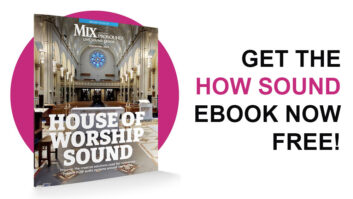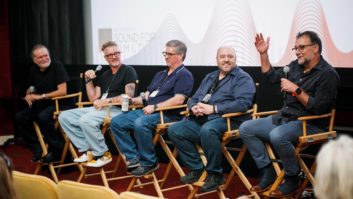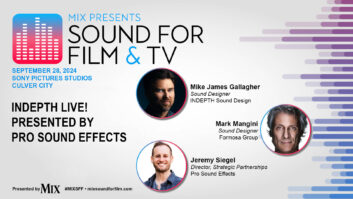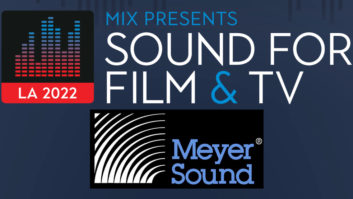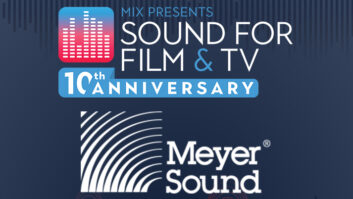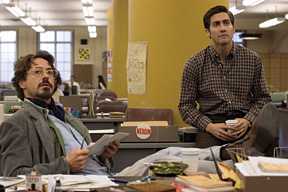
The Zodiac murders were a series of brutal, seemingly random killings in Northern California that baffled police and terrified residents in the late ’60s. Through the early ’70s, Zodiac taunted detectives and journalists with cryptic notes, and though many theories about the killer’s identity surfaced throughout the years, Zodiac has never been positively identified. The murder spree inspired a number of books, speculative TV shows and feature films (including Dirty Harry, whose psycho killer is known as Scorpio). But David Fincher, director of such gritty films as Se7en, Fight Club and Panic Room, is the first major filmmaker to tackle the story in all of its dimensions: Zodiac is a gripping crime drama, a police story and a saga about journalists in action — all rolled into one.
Photo: Merrick Morton
The film was shot at various locations around California and posted at Skywalker Sound and Tyrell Sound in Marin County. Fincher actually grew up in Marin, and early in his film career worked for Industrial Light & Magic there, before splitting off to make commercials, music videos and, eventually, features. Zodiac‘s post team included a host of regular or occasional Skywalker denizens, including supervising sound editor Richard Hymns, dialog mixer David Parker, effects mixer Michael Semanick, dialog editors Malcolm Fife and Rich Quinn, and ADR editor Gwen Whittle (all of whom have worked on past Fincher films), plus sound designer and music mixer Ren Klyce, another Marin native who has worked on all of Fincher’s features and runs his own sound design company based in Sausalito, Mit Out Sound.
On a lovely early fall afternoon, I headed up to Skywalker to check out the post work in progress. (The film was originally scheduled to be released in December; it comes out March 2.) Zodiac is taking up the facility’s three biggest studios, with Semanick premixing backgrounds in one room, Parker mixing dialog in another and, in the busiest hub that day, there’s music recording on the Scoring Stage, with engineer Leslie Ann Jones at the Neve 88R, Klyce supervising and composer David Shire conducting a 54-piece orchestra for assorted cues.
“Initially, David [Fincher] didn’t envision an original score for the film,” Klyce recalls. “He wanted it to be a tapestry of sound design, vintage songs of the period, sound bites and ethereal clips of [AM radio giant] KFRC and ‘Mathews Top of the Hill Daly City’ [home of a prominent hi-fi dealership of the time]. David and I both grew up in the Bay Area, and we remembered all these sounds from our childhood, like La Brea’s Warehouse waterbeds, Captain Mitch, Denevi Camera and on and on. I was apprehensive, however, because while reading the script, I kept seeing places where I thought, ‘This should have music — not just a pop song.’ Unfortunately, David had told the studio he didn’t need a composer and would buy a bunch of songs instead. They agreed. But as the film developed and hit its stride, I felt there were holes in some scenes that could benefit from music.
“So I started to reach for this music score that I really loved: Francis Coppola’s The Conversation, composed by David Shire,” he continues. “I got a CD of the score and started cutting it in [as a temp track], mostly for myself to feel what the film might be like with some solo piano underscore. I really loved the way the solo piano in The Conversation reflected Harry Caul’s character, so I thought that might be an interesting approach for the characters in our film. I started showing it to David, and he said, ‘Yeah, this is great, but I promised the studio I wasn’t going to put any music in it, so if you’re going to do that, it has to be all source music.’”
A number of e-mails between Klyce and noted sound and film editor Walter Murch, who had earned an Oscar nomination for his work on The Conversation back in 1975, led to one inescapable notion: The best way to get some of the feeling of Shire’s lonely piano music into Zodiac was to actually hire him to write some cues, studio be damned. With Murch’s help, Klyce contacted Shire and began detailing the plot and themes, talking about the idea of “the unraveling of the film’s characters.” Fincher remained apprehensive, but sent Shire a script and flew him in for a meeting and screening in Los Angeles. Soon after, the studio agreed to bring Shire onboard.
“At first, they wanted about 15 or 20 minutes of score,” Shire relates between takes on the scoring stage, “but it ended up growing into something bigger. Besides the piano-based score, I also brought along a classical recording I thought might have some of the texture I was looking for — a Charles Ives piece called ‘The Unanswered Question.’ I think it popped in my head one day because this whole movie is an unanswered question. So I brought in some of the Ives texture, and we also had some Conversation-based cues, and by the time we spotted the picture, we were up to 37 minutes of original music.”

Sound designer Ren Klyce, left, with composer David Shure
Once he had a sense of where the score was heading, Shire huddled with his producer and orchestrator, Martin Erskine, to flesh out the composer’s ideas. “We’d do the cue, then send it to Ren over an Internet system called PIX,” Shire explains. “Ren’s team would put it to picture and send it to Fincher’s office. Then he’d type his notes, and Ren would type his notes. It would come back to us, and Marty and I would work on it some more. We did that on 31 cues. It’s a lot of work, but it means that when you get to the scoring date, you don’t have a room full of musicians sitting around doing nothing because you’re suddenly rewriting cues. You can spend the recording session working on the last interpretive details. It’s been a great experience.”
Indeed, on the afternoon I was observing the scoring session, there was a mellow give and take of ideas between Klyce, Shire and Erskine, as Jones ran the session from the board. The orchestra (from the San Francisco Opera and S.F. Ballet orchestras) was nearly all strings — 14 first violins, 12 seconds, 10 celli and eight bassists — augmented by some solo trumpet, French horn, guitar (on one cue) and piano (not played by Shire, who was conducting; he recorded his solo cues on another day). Jones miked the orchestra with a combination of Neumann overheads and section mics, “and one thing we did that was a little different on this session is I asked David Shire if he wanted to split the first and second violins,” Jones says. “A lot of times, they’re right next to each other, but for this we separated them because of the way he had written the parts — they were playing mostly different lines, and that ended up being a big part of the sound of the score.” The session was recorded to Pro Tools at 24/96, though it was delivered to the stage at 24/48.
Klyce was deeply involved in each cue’s minute details. After a take of a slow, eerie crescendo, Klyce mentioned to Erskine that he thought that the build-up sounded “a bit cliché. It’s like ‘leading the witness.’” After some minor consultation, they decided to strip away the basses and taper the crescendo more. Over the talkback, the changes were relayed to Shire, who then passed them on to the orchestra. With the next take it was clear that the change was a good one, and everyone, Shire included, seemed pleased. And so it went. On one cue they worked in a new string ritard. On another, Klyce wanted the violas quieter. The piano was removed from a third cue. At one point, Fincher called in from L.A. and was patched into the session briefly so he could hear a cue or two.
“It was the best kind of collaboration on a film,” Shire notes. “The score evolves rather than the composer and director talking, then the composer disappears for six weeks, writes the score and the first time the director hears it is on the stage, which can lead to disaster.”
In many ways, Klyce was the fulcrum in the film’s production because he was intimately involved in both sound design and the score, and he is extremely close with Fincher and consults with him on matters large and small. It was a lot to juggle, but Klyce insists the needs of the film dictated how decisions came down.
“Just yesterday,” Klyce tells me at the beginning of the final mix a few weeks later, “Michael Semanick, David Parker and I were mixing, and all of a sudden I started pushing the music faders up, and I looked up at Michael, and said, ‘You know what — we’re going to have to lose all that intricate sound design we did here.’ I felt torn inside because we were discarding all our sound work, but with the combination of the sound design and Shire’s music, this weird alien music surfaced, making the scene sound dischordal. It wasn’t right. The good news was that because it was just us, there was no fighting about it. The sound editor in me was disappointed, but you move on.

Leslie Ann Jones, director of music recording at Skywalker Sound
“One good thing about being involved in both the sound design and the music is that I knew where the music was going to be important and I also knew what was happening with the effects and ambiences, so there were places where we tried to build the sounds around the music and vice-versa,” he continues. “Early on, when David [Shire] would send a mock-up of the piano, I would then try to put ethereal tones that would complement his music if I could.”
On the sound design side, Klyce says he became positively obsessive about having the proper period typewriter, phone and vehicle sounds — while also allowing room for creativity. “Throughout this project, I’ve become almost a typewriter fetishist,” he says with a laugh. “I started collecting them, and I had to stop because it started to get a little weird. I went on eBay and looked for some Olivetti — ‘I want the red one, too!’ It was the same with the vintage telephones.
“I wanted the Chronicle newsroom bullpen to have the IBM Selectric Model 1 sound and a certain kind of telephone ring, and then with my team we’d go record these typewriters at various locations [using a Sound Devices 722 digital 2-channel recorder]. So, for instance, we’d record an IBM Selectric at my home and record it from different perspectives — from 20 feet, sometimes in mono, sometimes in stereo. We did a ‘concert’ for two IBM Selectrics at 40 feet. We did the same thing with the telephones. We had the typewriters and telephones at the Chronicle being the ‘newer’ technology, and then the typewriters at the Hall of Justice, where the cops were, were all manual typewriters — since they’re government people!
“And even though it might not have been correct historically,” Klyce continues, “the phones for Hall of Justice have these 1920s rings. At one point, we took all the IBMs and the manual typewriters into a church in Mill Valley and recorded those from many perspectives. We also went onto the Skywalker Scoring Stage, which had a more ambient vibe. As my fetish grew, I started asking the prop people to send me their typewriters, so all these typewriters were showing up in these massive boxes from FedEx.”
He and supervising sound editor Richard Hymns brought a similar attention to detail to the period cars, which included everything from VW bugs to Ford Galaxies. “People who don’t do sound effects think, ‘Oh, don’t you just have a recording of a car going by?’” Klyce says with a chuckle. “‘Well, yeah, but it’s a not a Studebaker stopping past the mic in the rain at 15 miles per hour.’ Each vehicle angle or shot in the film must be re-performed. It’s tedious work, but worth the time and trouble it takes.”
Toward the end, even Fincher got into the act, coming up with an audacious audio idea of his own: After many different actors (including dialog editor Malcolm Fife) lent their voices to the mysterious (but never fully seen) Zodiac, Fincher said he wanted to splice together two different actors’ voices to form a single performance (alternating each word). “[ADR editor] Gwen Whittle and I thought it was a pretty bad idea and that it would never work,” Klyce says. “Splicing from one actor to another? Forget it! We said, ‘Okay, let’s just do it and show David that it can’t work.’ So Gwen started to do this — and it worked! It was so weird.
“Besides,” he adds, “it is his movie. But if it were wrong, David would want to know. He wants it to be as good as it can be.”

